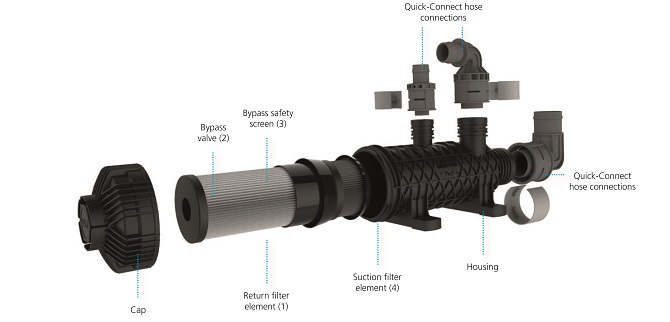The new “2in1” suction-return filter from ARGO-HYTOS is reportedly an innovative, combined system designed to economically handle cold-start situations.

The ARGO-HYTOS 2in1 design combines a suction filter and return filter in one housing.
In tractors and other mobile machines with a mixed-response, common oil circuit for transmission and power hydraulics, a suction filter is usually used to protect the pump, while a return filter ensures proper oil cleanliness. In order to protect the system during a cold start, a coarse safety screen is often also installed in the suction line.
The disadvantage of this conventional design is that the two filters in the suction line have a negative effect on the cold-start performance. In addition, the use of at least two filters results in high cost for the initial installation, as well as for spare parts costs. By combining a suction filter and return filter in one housing, the 2in1 filter can improve the situation, said company officials.
The unit offers nominal volume flow of 140 l/min (37 gpm) in the suction line, 100 l/min (26.4 gpm) in the return line, and 40 l/min (10.6 gpm) in the tank line. Filter fineness is 16 μm(c) for the return filter, 100 μm(c) for the suction filter, and 280 μm for the bypass protective screen.
The accompanying graphic shows the unit’s construction. Oil coming from the working hydraulics flows through the return filter element (1) and is directly supplied to the pumps. If the working hydraulic system feeds less oil into the return line than the pumps need to supply, the pumps draw additional oil from the tank via the suction filter element (4). The protective screen (3) prevents coarse particles from entering the system when the bypass (2) is open.

Exploded view of the 2in1
The housing of the new 2in1 filter is equipped with the ARGO-HYTOS Quick-Connect system. This allows for quick and straightforward installation of hoses to the filter housing. Users can choose from more than 20 different connectors with different sizes and shapes.
This innovative filter concept is particularly suitable for hydraulic circuits such as those in small and medium-sized tractors, said the company. Among reported customer advantages are excellent cold-start performance, lower installation costs, fewer maintenance points, and long service life due to use of ExaporMAX 2 filter elements.
ARGO-HYTOS
www.argo-hytos.com
Filed Under: Filtration/Contamination Control, Sealing & Contamination Control Tips